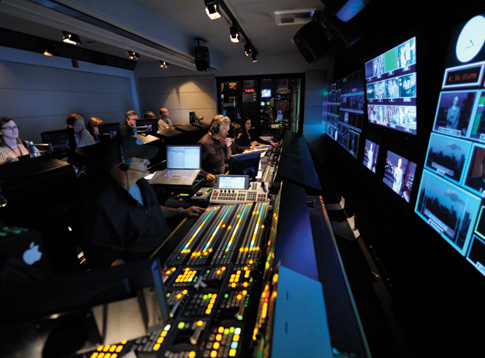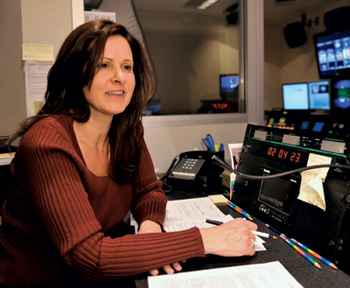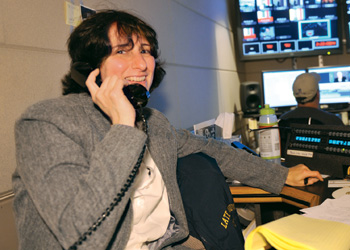BY ANN FARMER
Photographed by John Paul Filo
 BLAST OFF: Director Jerry Foley (center) cuies shots from the control
BLAST OFF: Director Jerry Foley (center) cuies shots from the control
room with assistance from associate director Randi Grossack (right).
Foley says his job is "to prevent the laugher from stopping."
Joaquin Phoenix had barely taken his seat on the Late Show with David Letterman in February when everyone in the control room instinctively hushed. It wasn't clear whether the straggly-haired actor was bluffing behind his dark sunglasses, incessant gum chewing and befuddled answers. But as far as the directing team was concerned, his bizarre behavior was an opportunity not to be squandered.
"These personally are my favorite moments with Dave," says Late Show director Jerry Foley. "Because you know that Dave's going to work." Which is to say that Letterman immediately understood how to milk the interview for all it was worth: matching Phoenix's awkward silences with his own (while mugging sideways to the camera) or asking Phoenix, poker-faced, "What can you tell us about your days with the Unibomber?"
Meanwhile, Foley got locked in with the dynamics onstage, cutting back and forth between the two or widening to two-shots, like when Phoenix belligerently stuck his gum to Letterman's desk. "Your primary responsibility is not to get in the way," explains Foley. "Don't smother it. Don't miss it." At one point, Letterman's music director and sidekick, Paul Shaffer, let loose a conspiratorial-sounding laugh. When Phoenix rebuked Shaffer, Foley quickly cut to that exchange. "You've got to get right to Shaffer," says Foley. "Then back to Joaquin. Then back to Dave to catch his reaction. It's my job to show you at home as much as possible of what's going on in that theater." That night when the show aired, the cuts worked so smoothly, it looked like they had been blocked out beforehand. During the next few months, the interview sequence was watched on YouTube millions of times and continues to be touted as one of the most memorable (if flummoxing) guest appearances in Late Show's history.
As the director of the Late Show for 14 years and the person re-sponsible for the look of each broadcast (he also has a supervising producer credit), Foley and his team of four stage managers and four associate directors have successfully facilitated any number of indelible guest appearances: From Letterman's skewering of a squirmy, post-jail Paris Hilton to his sparring with the querulous talk show host Bill O'Reilly. Foley's biggest challenge, however, isn't the guests. It's keeping pace with a host whose talent lies in his ability to be extemporaneous.
When Letterman impulsively balls up a notecard and throws it at the prop window, Foley and his team must instantly match it with the sound of shattering glass. When Letterman gets it in his head to walk into the audience or out the stage door, Foley has to post a cameraman right on his tail. When Letterman decides to shoot a husband and wife team out of a cannon on 53rd Street or blow up a mutant, 1,000-pound pumpkin, Foley makes it happen safely. He also records it from every angle so that Letterman can gleefully replay the spectacle of flying pumpkin carnage over and over.
"I'm supposed to prevent the laughter from stopping," says Foley, explaining that the best way to do that is to ensure that Letterman is never distracted from his game. "If the average viewer is aware that this show is being directed, then I've failed."
On a recent Monday, Foley arrived as usual for the 10:15 a.m. preproduction meeting at the Ed Sullivan Theater in Times Square where the show is taped, to hash out rudimentary rundowns of Monday and Friday's show (both are taped that day) with the producers, writers and members of the directing team. Even though the Late Show has a structure and regular bits, the episodes are primarily created from scratch that day. The writers arrive with ideas for jokes, stunts, comedic sketches and regular segments such as the Top Ten List. Foley determines the technical and logistical requirements to pull them off.
 THE A-TEAM: Letterman's spontaneity is ingrained in the staff.
THE A-TEAM: Letterman's spontaneity is ingrained in the staff.
Associate director Jessica Santini.

Stage manager Biff Henderson.

Associate director Randi Grossack.

Director Jerry Foley.

Stage manager Frank Comito.
However, nothing is definite until Letterman gives it his stamp of approval. The only certainty is the guest. And even he or she can fall through, as when presidential nominee Senator John McCain canceled hours before his scheduled appearance last fall, claiming to be on his way to Washington, D.C., where he said his presence was needed to deal with the economic crisis. Then Foley got word that McCain was actually appearing five blocks away on the CBS Evening News with Katie Couric. Tapping into a live CBS internal feed, Foley was able to connect to a camera in that studio and, in the middle of the Late Show taping, punch up a live shot of McCain getting his face powdered. Letterman ran with it. The next day McCain's blunder was all over the news.
Once the writers' scripts get distributed around 11:30 a.m., Foley's entire crew (which includes camera and videotape operators, electricians, wardrobe, graphics, props, etc.) begins its race against the clock. Associate director Randi Grossack, who maintains the show's tape library and sits directly to Foley's left during tapings to funnel him information from the executive producers, starts pulling footage to roll into the show. One writer's tentative tape package today has Letterman making a farcical joke about the White House Correspondents' Dinner that took place over the weekend. In accordance with the script, Grossack locates satellite footage from the event, which is edited with an old clip of Don Rickles roasting Dean Martin to make it look as though President Obama is laughing at Rickles' off-color jokes.
Because the rundown is constantly fluctuating, Grossack estimates that about one out of every five fully produced tape packages ultimately gets aired. One piece that makes it on today's show is assigned only two hours before the 4:30 p.m. taping, when Letterman watches the launching of the space shuttle Atlantis and decides to manipulate the footage to make it look like a water tower next to the Atlantis launched instead. "We scrambled to make the water tower take off instead of the shuttle," says Grossack, describing how 20 minutes before taping, Letterman asked for changes. "He wanted the smoke to start earlier and the water tower to travel slower. You think, 'Okay, that's simple.' But it's more complicated and that's when anxiety starts getting higher."
Understanding Letterman's quirky sense of humor helps. "It's so ingrained in me by now," says Grossack, describing, for instance, how she stalked President George W. Bush in the satellite news feeds for the past eight years because Letterman took such pleasure in poking fun at him. "When Bush walked down the White House lawn and spit, you knew the second he did that that Dave would love it," says Grossack, who passed all promising Bush clips on to the writers.
Letterman also has a number of archival clips that he likes to return to time and again. No one knows when he might suddenly indicate, in the middle of taping, that he wants to jump to a favorite one. "And if he has to ask for it, it's ruined," says Foley, who can't communicate directly with Letterman during tapings because Letterman doesn't wear an earpiece. Instead, he and his crew listen hard for any verbal clues. If, for example, Letterman makes a reference to Zeke, the dog that famously nipped at him during a segment of Stupid Pet Tricks in 2000, everyone starts scrambling. "It has to be ready instantaneously," says associate director Jessica Santini, whose job is to supervise the edit room during preproduction. Once the show begins, she sits to Grossack's left, counting the ins and outs of taped pieces and helping to keep everyone one step ahead of the action. She says they've created an efficient system for locating show staples. "We can usually find [the Zeke] clip in less than 30 seconds."
Stage directions are also up for grabs. "Four minutes before going live," says stage manager Frank Comito, "Dave may decide he wants to go with Rupert," referring to nearby deli owner Rupert Jee, who is regularly utilized as a Letterman accomplice. "He'll say, 'Rupert, why don't you go to Jamba Juice?' All of a sudden we're crossing Broadway." Or, says Comito, "Dave may find an audience member and send him into FlashDancers [an adult men's club] for a drink." Comito recalls the time that Letterman decided to end the show by hopping on motorcycles with actors Bruce Willis and Sylvester Stallone and driving away. "Dave is the kind of guy who doesn't want to be figured out. He wants to be unpredictable," says Comito. "He likes to take charge of the show, and when he decides it's time to do it, that's when he does it. We're always on a fire drill. We never let our guard down."
Foley has learned to facilitate Letterman's spontaneity by stationing a cameraman by the stage door exit. It also helps that most of Foley's crew, including his technical director Tim Kennedy and the camera operators, have been with the show for many years. "When [Letterman] jumps offstage or cuts his tie off, I can't tell people what to do," says Foley. "By the time I say pan left, he's left that part of the stage. You can't train someone in a day to guess David Letterman's moves or guess his favorite things. You just have to know."
Because the audience is admitted promptly at 4 p.m., there is little time to rehearse skits. Tom Hanks is today's guest. When he arrives, Foley meets him in a section of the balcony, which the stage crew has covered in burlap and dirt to shoot a parody of Hanks' new film Angels & Demons. Foley shows Hanks where to enter and tells him, "You're creeping around. You step over this. This is where the money is, over here," he says, pointing to a pile of dirt where something with two visible letters—O and R—is poking out.
"I got it, I got it," says Hanks, going through his lines in a low, inquiring tone. "Is this the long lost book of prophecies written by the Orion Brotherhood? Or is it an ancient artifact belonging to the Order of the Illuminati? Wait a minute. Wait a minute," he says, as he brushes the dirt away, "These are Oreos." He pulls one out and takes a bite. "Hey, these are delicious." He turns to Foley, "I said 'delicious' instead of 'tasty.' Is that okay?" Later, during the actual taping, Hanks tells such a long and engrossing story about his dogs getting skunked that the skit gets cut.
Foley must also coax professional performances out of non-professional performers. In fact, several of today's sketches feature members of the Late Show staff, including its receptionist, cue card guy, and stage manager Biff Henderson, who does a so-called exit interview with Hanks. "How do you describe Dave's handshake?" asks Henderson matter-of-factly, his checklist in hand. "Greasy, sweaty, like handling old lunchmeat," replies Hanks, which gets a chortle from the control room.
Henderson has been with the Late Show from the beginning. In his real job as stage manager, he works backstage during taping directing traffic and prepping guests for their appearances. "A lot of them tell me that they're nervous and I make them feel comfortable," says Henderson, describing, for instance, how some novice guests, like the pet owners in Stupid Pet Tricks, turn to him for advice. "I say, 'Please don't try to be funny. Be yourself. The humor will come out and you may be funnier than you think.'"
He also serves as an additional pair of ears and eyes for Foley. "He wouldn't know some stuff going on if we didn't tell him," says Henderson, who warned Foley today that during the pre-show audience warm-up, Letterman honed in on a honeymooning couple and was planning to bestow free dinner passes on them during the taping.
While Henderson works backstage, Comito works the front as Foley's middleman. He positions himself in front of Letterman, next to the cue card holder and the cameras. Just before the taping begins, Comito gets down on one knee to hand-signal the countdown to the show and to provide Letterman other nonverbal cues. He keeps his eyes glued on Letterman for the entire hour to determine if and when he needs something. "If he stares at you, you know something's wrong. Maybe he needs a time cue. Or maybe he doesn't want to be on that segment any longer," says Comito, who alerts Foley.
"At the end of the day, it all comes down to Jerry," says Comito, recalling how Foley was placed in a particularly tough position when Comito was sent to Bosnia to help coordinate a live remote show with the troops. The satellite feed kept going down. And with only minutes to airtime, Comito couldn't get the previous act to leave the stage in Bosnia. Foley directed him to do whatever it took, which required Comito crawling on his hands and knees to a potted plant onstage where he was able to signal the singer/songwriter Carole King to clear the deck. "The last thing I heard from New York was Jerry saying, 'Take the beach. Take the beach,' says Comito. "I knew what he meant."
Foley began his broadcasting career as a freelance cameraman before getting hired by NBC in 1980 as an electronics graphics technician. He was eventually promoted to the position of technical director, joining NBC's Late Night with David Letterman in 1990. When Letterman shifted to CBS in 1993, he was invited to come along. He succeeded Letterman's longtime director Hal Gurnee two years later. "I am the keeper of the flame," says Foley. "If I'm doing anything, it's being true to what Hal and Dave did in the beginning."
Occasionally Foley messes up, such as the time he cued Walter Cronkite to walk onstage while Letterman was in the middle of his monologue. "It's a very lonely moment because it's geared toward one guy making a decision," says Foley. "The good thing is, you're allowed to fail. But you can't fail the same way twice."
Foley has been nominated eight times for the DGA Award for Directorial Achievement in a Musical/Variety Program. His most satisfying Late Show moments include the time he orchestrated 50 Marines to march in cadence down Broadway and into the theater. Then there was the daredevil stuntman who dove seven stories into a 10-foot pool of water. Just before taking off, a fly landed on the lens of the lipstick camera that Foley had positioned to capture the feat from above. "Of all of the cameras in all the cities in the world, why did he have to land on mine?" cracks Foley, who had a split-second to switch to a less compelling shot. He took his chances. The fly buzzed away. And Letterman not only had the satisfaction of replaying the dive shot forward and backward, he got more laughs by playing the fly shot, too.
"My contribution," says Foley, "is to create an environment for people to be funny in. Really and truthfully, the only funny guy is Dave. The rest of us are working off what he does. With that comes a lot of responsibility."